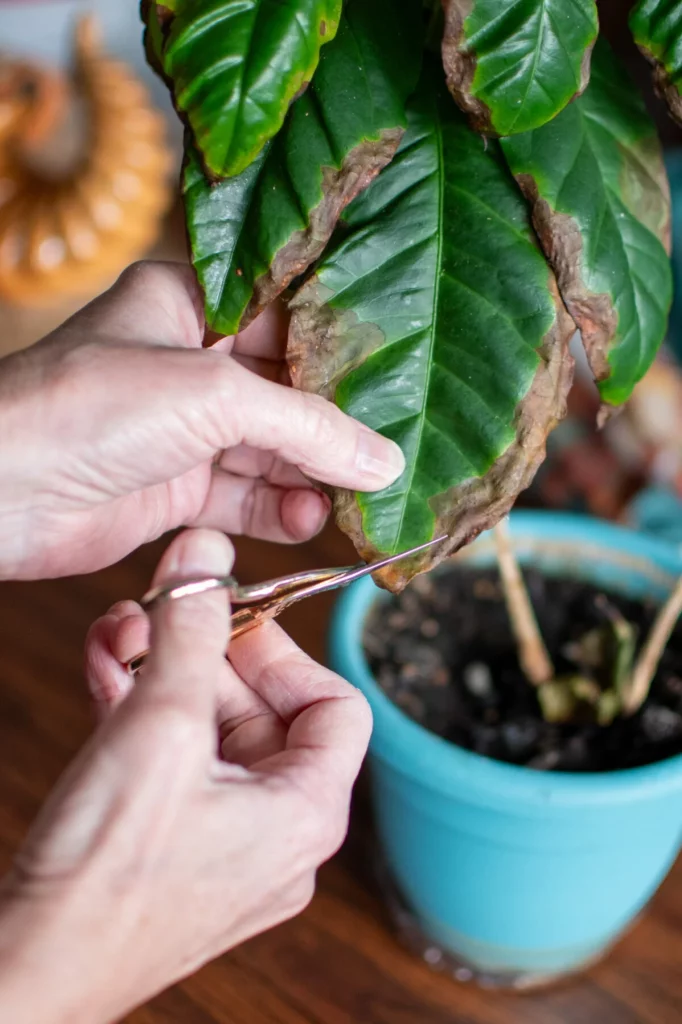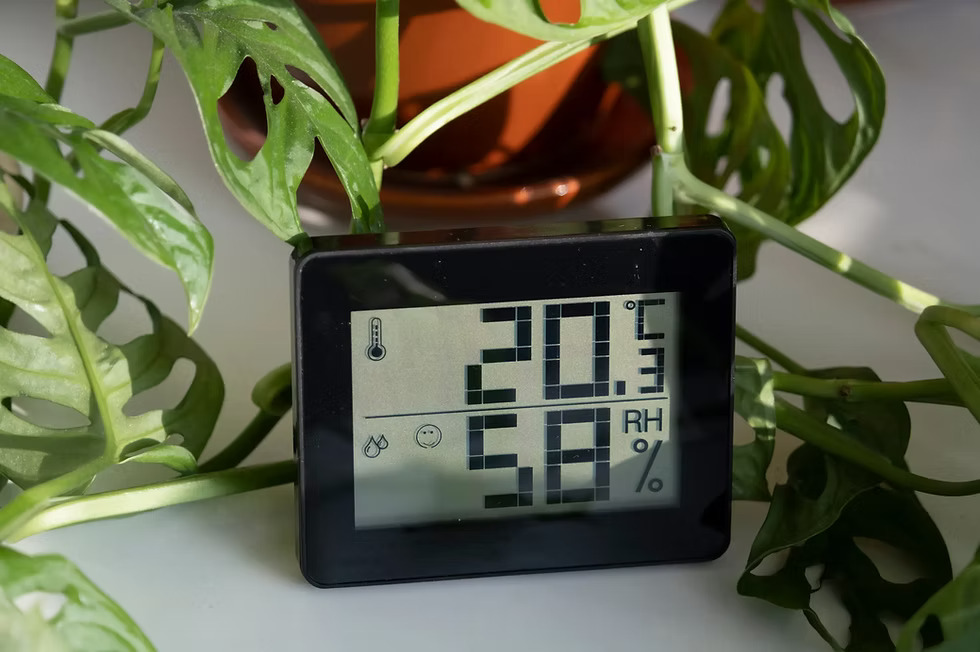Contents
- 1 How to Balance Humidity for Indoor Plants (Avoid Dry Air & Leaf Curl)
- 1.1 Why Humidity Matters for Indoor Plants
- 1.2 Ideal Humidity Levels for Indoor Plants
- 1.3 Simple Ways to Increase Humidity Indoors
- 1.4 Smart Ways to Monitor Humidity
- 1.5 How to Lower Humidity (If It’s Too High)
- 1.6 Seasonal Humidity Adjustments
- 1.7 FAQs About Indoor Humidity
- 1.8 Final Thoughts on Balancing Humidity Indoors
- 2 Indoor Plant Grow Light Guide
How to Balance Humidity for Indoor Plants (Avoid Dry Air & Leaf Curl)
KEEP YOUR PLANTS HAPPY, EVEN IN DRY AIR
If your indoor plants are getting crispy edges, curling leaves, or brown tips — it’s probably not your watering schedule. It’s low humidity.
Indoor heating, air conditioning, and seasonal changes can all strip moisture from the air, leaving your plants thirsty for humidity. Luckily, with a few easy adjustments, you can restore the perfect indoor climate and keep your greenery thriving all year long.
Why Humidity Matters for Indoor Plants
Humidity is the invisible ingredient your plants depend on — even more than sunlight in some cases.
It’s what keeps leaf cells hydrated and roots absorbing water efficiently. When air gets too dry, leaves lose moisture faster than the roots can replace it.
Common Signs of Low Humidity
Brown or crispy leaf edges
Curling or drooping leaves
Stunted growth
Wilting even after watering
For more on fixing water-related stress, see Top 5 Indoor Plant Watering Mistakes (And How to Avoid Them).

Ideal Humidity Levels for Indoor Plants
Most tropical houseplants prefer humidity levels between 50% and 70%.
Unfortunately, the average home sits around 30–40%, especially during colder months when heaters run frequently.
Here’s a quick reference:
| Plant Type | Ideal Humidity | Symptoms of Low Humidity |
|---|---|---|
| Tropical plants (Monstera, Philodendron) | 60–70% | Curling, yellowing leaves |
| Ferns & Calatheas | 70–80% | Crispy leaf edges |
| Succulents & Cacti | 30–40% | Usually tolerant |
| Bonsai & Ficus | 50–60% | Brittle leaves |
Simple Ways to Increase Humidity Indoors
You don’t need to turn your living room into a rainforest — small changes make a big difference.
1. Use a Humidifier
A plant humidifier is the most effective way to raise humidity quickly and evenly.
Choose a cool mist model for safe, long-term use.
Place it a few feet away from plants to prevent leaf spotting.
Run it for a few hours each morning during dry seasons.
Look for quiet, automatic humidifiers designed for houseplants — many feature built-in hygrometers that maintain consistent humidity.
2. Group Plants Together
Plants release water through a process called transpiration. When placed close together, they create a mini microclimate — increasing local humidity naturally.
Try clustering similar species (like tropicals or ferns) in one area for best results.
🪴 Pro Tip: Avoid overcrowding — air circulation is just as important as moisture.
3. Use Pebble Trays
A classic, low-cost trick that really works.
Fill a shallow tray with pebbles and water.
Place your pots on top (not submerged).
As the water evaporates, it humidifies the air around your plants.
Check and refill the tray weekly to maintain steady moisture.
For a full guide, see How to Use Humidity Trays for Houseplants (Beginner’s Guide).
4. Mist Plants Correctly
Misting can be helpful — but only when done properly.
Use room-temperature water.
Spray in the morning so leaves dry before night.
Mist leaf undersides, where moisture is absorbed.
Avoid misting plants with fuzzy or delicate leaves (like African violets), as it can lead to mold or leaf spots.
5. Control Airflow and Heat Sources
Fans, radiators, and heating vents can rapidly dry out air. Move plants away from direct airflow or heat, especially in winter.
Instead, place them near windows or diffused light areas with stable temperature and moisture.
If you’re using a fan for airflow, set it on a low, oscillating setting to prevent stagnant air without stripping humidity.
Smart Ways to Monitor Humidity
Just like light and water, humidity can be tracked and optimized.
📊 Hygrometers
Small digital devices that monitor air moisture. Some even pair with apps, alerting you when humidity drops too low.
🌱 Smart Plant Sensors
Advanced models like the Xiaomi Mi Flora Sensor or Parrot Flower Power track soil moisture, humidity, and temperature — giving you real-time feedback for perfect conditions.
You can find accurate digital hygrometers and smart sensors on Amazon — perfect for monitoring multiple plants at once without the guesswork.

How to Lower Humidity (If It’s Too High)
Sometimes, the opposite problem occurs — especially in bathrooms, kitchens, or greenhouses.
🧽 To reduce excess humidity:
Increase airflow with a small fan or open window.
Water plants less frequently.
Add perlite or pumice to soil to prevent root rot.
Run a dehumidifier during extreme dampness.
Balanced humidity prevents fungal growth, mold, and pests — a common issue in closed spaces.
Seasonal Humidity Adjustments
Different times of year affect your indoor air dramatically:
Winter: Heaters and radiators dry out air fast — run humidifiers daily.
Summer: Humidity rises naturally; monitor for mold and reduce misting.
Spring & Autumn: Transition seasons — great time to repot and refresh soil.
By syncing your humidity habits with the seasons, your plants will grow more evenly and experience fewer leaf issues year-round.
FAQs About Indoor Humidity
1. Can I just boil water or shower nearby for humidity?
Yes, but the effect is temporary. For lasting results, use pebble trays or humidifiers.
2. What’s the easiest low-cost humidity fix?
Grouping plants together and using pebble trays — effective and nearly free.
3. Can too much humidity hurt plants?
Absolutely. Constant dampness can cause mold, root rot, or fungal leaf spots. Always balance humidity with airflow.
Final Thoughts on Balancing Humidity Indoors
Humidity is one of the most overlooked elements in indoor gardening, yet it’s essential for keeping plants lush and stress-free. By fine-tuning your environment — whether through humidifiers, plant grouping, or simple trays — you can create a thriving mini-climate your plants will love.
Healthy air = healthy leaves. Once you master humidity, everything else becomes easier.
🌿 Related Articles
KEEP YOUR PLANTS GLOWING YEAR-ROUND
Indoor Plant Grow Light Guide
Learn how to give your plants the perfect light balance for strong growth and greener leaves — even when natural sunlight is limited.

